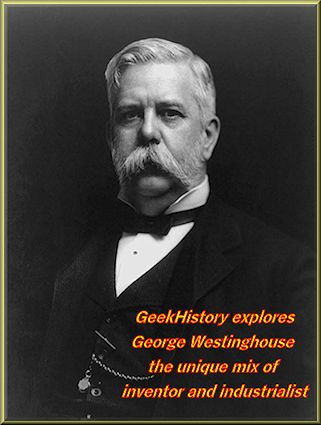 George Westinghouse is often listed as an industrialist or entrepreneur. Many times when people call someone an industrialist, rather than an inventor, they are implying the person was not an inventor themselves, but bought and sold other people's ideas. But George Westinghouse was very much an inventor, and a life long geek who loved to tinker with machinery.
George Westinghouse is often listed as an industrialist or entrepreneur. Many times when people call someone an industrialist, rather than an inventor, they are implying the person was not an inventor themselves, but bought and sold other people's ideas. But George Westinghouse was very much an inventor, and a life long geek who loved to tinker with machinery.
George Westinghouse was the son of a New York agricultural machinery maker, the owner of the G. Westinghouse and Company Schenectady Agricultural Works. As a boy George was not a good student, it is said he was bored in the classroom. He loved mechanics and working in the machine shops of his father's factory. A foreman in his father's shop took an interest in George junior and gave him the tools and encouragement to build water wheels and steam engines in his fathers shop. Later in life Westinghouse said the best education he had was the ability to work in his father's shops.
At an early age Westinghouse worked on various inventions involving rotary steam engines and improving the railway system, at age of 19 Westinghouse was awarded his first patent for a rotary steam engine. Westinghouse moved to Pittsburgh at the age of 21 in search of the steel he needed for his inventions in rail transportation. At age 22 he was awarded a patent for one of his most important inventions, the railroad air brake. This device enabled trains to be stopped with fail-safe accuracy by the locomotive engineer for the first time and was eventually adopted on the majority of the world's railroads. The Westinghouse Air Brake Company was founded on September 28, 1869 by George Westinghouse in Pittsburgh, Pennsylvania.
The War of Currents
Many articles are written about the great fight between Thomas Edison and Nikola Tesla over the distribution of electricity in America known as the War of Currents . What is really sad is all the internet hype on Nikola Tesla and the cries of how Tesla is forgotten. The often forgotten man who won the War of Currents against Thomas Edison was George Westinghouse.